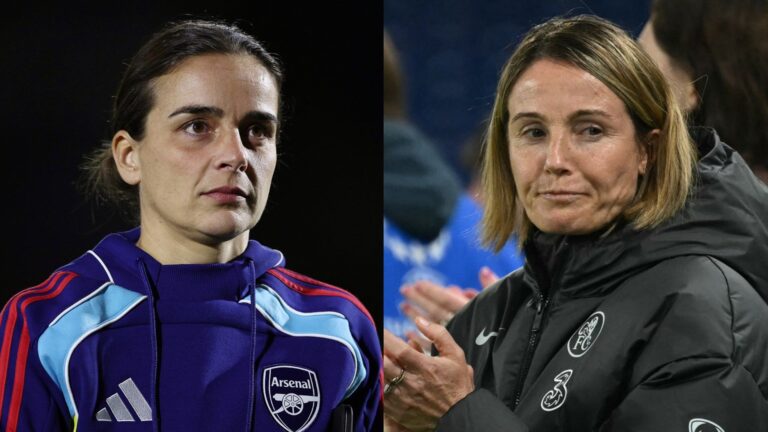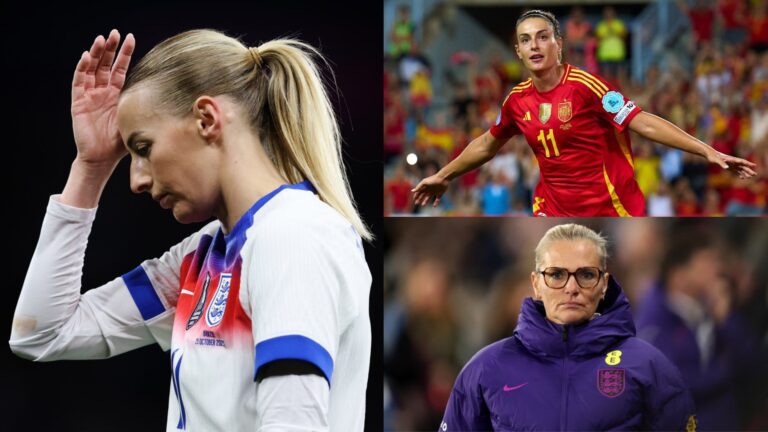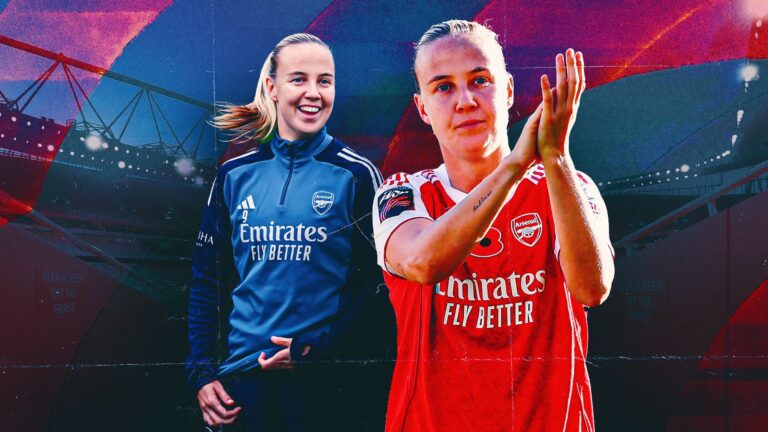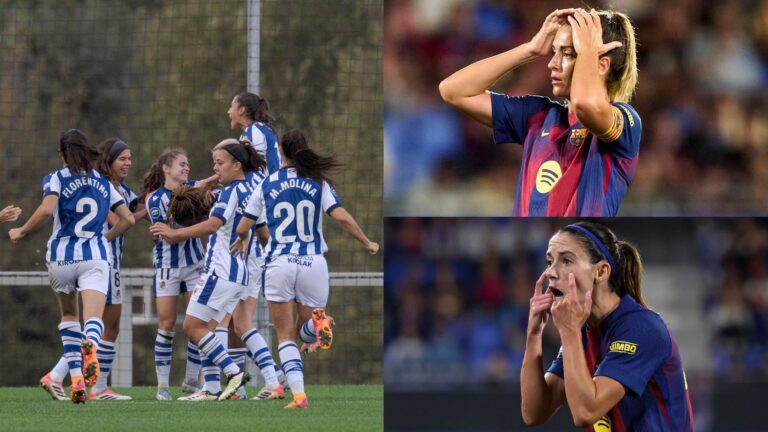

Lena Oberdorf’s Heartbreaking Battle with ACL Injury Strikes Again
In the world of women’s football, Lena Oberdorf‘s resilience and skill have always shone brightly, but now she’s confronting yet another major hurdle that could sideline her for months. This piece explores the tough road ahead for the Bayern Munich and Germany star following her second ACL tear, highlighting the emotional and professional challenges while emphasizing the unwavering support surrounding her.
Oberdorf’s Recent Injury and Recovery Outlook
Bayern Munich made the announcement earlier this week, following an incident that forced Oberdorf out of their dominant 5-1 match against Cologne in the Frauen-Bundesliga. This adaptable player in the midfield position is lined up for an operation on Tuesday, which could mean she’ll be absent for the majority of the 2025-26 campaign, even though the season has only just kicked off, underscoring the unpredictable nature of sports injuries.
Club’s Response and Commitment to Support
Bianca Rech, who leads the women’s football operations at the club, shared her deep concern, noting, “This development has hit everyone hard, and we’re all thinking of Lena.” She praised Oberdorf’s relentless effort and resolve after her initial setback, calling this new obstacle devastating. “We’re completely committed to standing by Lena, offering every bit of assistance possible as she navigates this period.”
Widespread Solidarity from the Football Community
In response to the update, Oberdorf has been met with an outpouring of encouragement from across the women’s football scene. She shared a snapshot on Instagram capturing her on the pitch for Bayern at the season’s outset, captioned “until we meet again,” prompting responses from current and former teammates, as well as rivals like the acclaimed three-time Ballon d’Or recipient Aitana Bonmati.
Messages of Strength and Encouragement
Bonmati’s message was straightforward: “Stay strong,” joined by past Wolfsburg associates such as Ingrid Engen, Jule Brand, and Alex Popp, along with numerous Bayern players. This wave of backing arrives as Oberdorf braces for yet another demanding rehabilitation journey, illustrating the tight-knit bonds in professional sports.
Reflecting on the First Injury and Its Impact
Back in August, the 23-year-old spoke candidly to Bayern’s magazine about the struggles of recovering from her debut ACL injury in July 2024 during a national team appearance for Germany. This not only kept her from the Olympic Games shortly after, where Germany claimed bronze, but also from Euro 2025, despite the event occurring a year later. Oberdorf described the recovery as “extremely challenging,” adding, “I’m not one for waiting around- it felt unbearable.”
Anticipating the Road to Recovery from a Second Tear
Now, overcoming this repeat injury presents a fresh test for Oberdorf, leaving both Bayern Munich and the German squad to adapt without her once more. Fortunately, the next big international event, the 2027 Women’s World Cup in Brazil, is nearly two years away, yet there’s still a packed schedule ahead, including Germany’s aspirations in the upcoming Nations League finals starting soon, where her absence as a pivotal figure will be keenly felt.
Bayern’s Aspirations Amid the Setback
For Bayern, the focus remains on extending their streak of three straight Bundesliga victories and pushing further in European competitions, having reached the Champions League semi-finals only once in the 2020-21 season. Their recent 7-1 defeat to Barcelona highlights the work needed, and losing a top-tier defensive midfielder like Oberdorf makes the path even tougher, emphasizing her critical role in the team’s dynamics.
Lessons from the Previous Break
Although Oberdorf labeled her earlier rehabilitation as “agony,” she acknowledged some unforeseen benefits, similar to what teammate Giulia Gwinn had mentioned but she hadn’t fully grasped until experiencing it. “I was skeptical at first,” she reflected. “All I wanted was to get back on the field. Looking back, that time away ended up being somewhat beneficial in unexpected ways.”
She elaborated, “Football defined me almost entirely, but I’ve come to realize my value isn’t diminished by a few mistakes on the pitch. This period has taught me a great deal about my own identity, revealing how I’ve overlooked various aspects of who I am over time.”
Looking Forward with Hope
As Oberdorf embarks on this challenging phase again, the focus is on discovering similar silver linings during her extended recovery, fostering personal growth alongside her return to the game she loves.
Who is Lena Oberdorf?
Lena Oberdorf is a rising star in women’s football, known for her defensive prowess and versatility on the pitch. As a key midfielder for Bayern Munich and the German National Team, she’s made a name for herself with her tactical intelligence and physical strength. Fans often highlight her ability to control the midfield, making her an essential player in both domestic and international competitions.
Oberdorf’s journey in football began at a young age, quickly progressing through the ranks in Germany. She has represented her country in major tournaments, including the FIFA Women’s World Cup and the UEFA Women’s Championship. Her style of play, characterized by strong tackling and precise passing, has drawn comparisons to some of the best in the game, solidifying her status as a fan favorite.
The Second ACL Injury: What Happened?
In the world of women’s football, ACL injuries can be devastating, and Lena Oberdorf’s second ACL injury in just 15 months has raised concerns about her long-term health. This type of injury, which involves the anterior cruciate ligament in the knee, is common among athletes who make quick pivots and high-impact movements, like those in soccer.
Details from reports indicate that Oberdorf’s latest ACL injury occurred during a match for Bayern Munich, forcing her to face a prolonged absence from the game. Recovery from an ACL injury typically involves surgery followed by extensive rehabilitation, which can sideline players for six months or more. For Oberdorf, this marks a challenging setback, as her first ACL injury happened earlier, disrupting her momentum and participation in key events for the German National Team.
- Key facts about ACL injuries in women’s football:
- Women athletes are at a higher risk for ACL tears due to factors like biomechanics and hormonal influences.
- Common symptoms include sudden pain, swelling, and instability in the knee.
- Rehabilitation often includes physical therapy, strength training, and gradual return-to-play protocols to minimize the risk of re-injury.
This second injury highlights the physical demands on players like Oberdorf, who frequently compete at the highest levels, and underscores the need for better injury prevention strategies in women’s sports.
Impact on Bayern Munich and the German National Team
The prolonged absence of Lena Oberdorf due to her ACL injury has significant implications for both Bayern Munich and the German National Team. For Bayern, losing a central figure in their midfield could affect their performance in the Frauen-Bundesliga and European competitions. Teams often have to adapt their strategies, relying on depth in the squad to cover for such absences.
On the international stage, the German National Team faces challenges without Oberdorf, especially in upcoming ACL injury-related absences that could impact World Cup qualifiers or friendlies. Her role as a defensive anchor means opponents might exploit gaps, putting pressure on other players to step up.
- How teams might cope:
- Squad rotation: Coaches could promote younger talents or adjust formations to maintain balance.
- Mental health support: Teams often provide psychological resources to help players like Oberdorf stay motivated during recovery.
- Long-term planning: This situation emphasizes the importance of injury management programs, including ACL injury prevention drills and load monitoring.
Fans and analysts are watching closely to see how these teams perform without her, as her absence could influence outcomes in women’s football leagues and tournaments.
The Road to Recovery for Athletes with ACL Injuries
Recovering from an ACL injury requires a multifaceted approach, and for Lena Oberdorf, this process will be crucial for her return to Bayern Munich and the German National Team. Rehabilitation typically starts with immediate post-surgery care, focusing on reducing swelling and regaining mobility, before progressing to strength-building exercises.
Experts recommend a timeline that includes:
- Phase 1 (0-6 weeks): Rest, icing, and gentle range-of-motion activities to protect the knee.
- Phase 2 (6-12 weeks): Introducing weight-bearing exercises and balance training to rebuild stability.
- Phase 3 (3-6 months): Sport-specific drills, such as agility work tailored to football, to prepare for competitive play.
Oberdorf’s experience with a previous ACL injury might give her an edge in understanding the recovery process, but it also adds emotional layers, as repeated injuries can affect confidence. Staying engaged with ACL injury rehabilitation tips, like incorporating yoga for flexibility or using bracing techniques, could help her comeback.
Challenges and Opportunities in Women’s Football Injury Prevention
Injuries like Lena Oberdorf’s ACL tear spotlight broader issues in women’s football, such as the need for enhanced training protocols and better access to medical resources. Teams like Bayern Munich are increasingly investing in ACL injury prevention programs, which include warm-up routines and strength conditioning to reduce risks.
- Emerging trends in prevention:
- Neuromuscular training: Programs that improve coordination and landing techniques have shown promise in lowering ACL injury rates.
- Gender-specific research: Studies focusing on women’s football are helping develop tailored strategies, addressing factors like menstrual cycle impacts.
- Technology integration: Wearables and AI-driven analytics are being used to monitor player loads and predict potential injuries.
For Oberdorf, this period of prolonged absence could open doors to advocacy, where she shares her story to promote ACL injury awareness and support for female athletes in Germany and beyond. By focusing on these aspects, the sport can evolve to protect its stars and ensure sustainable careers.









